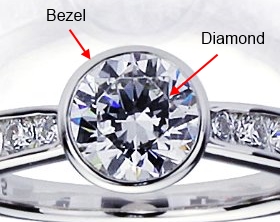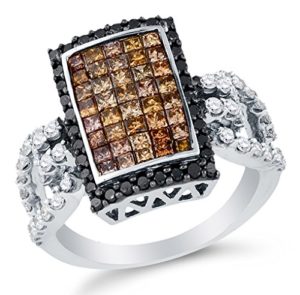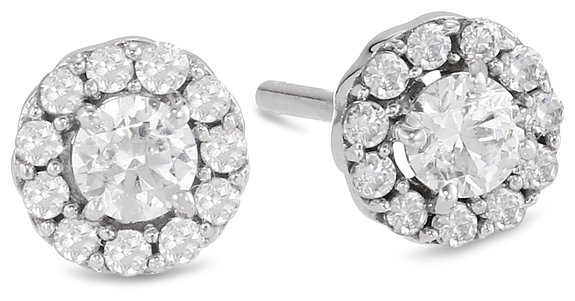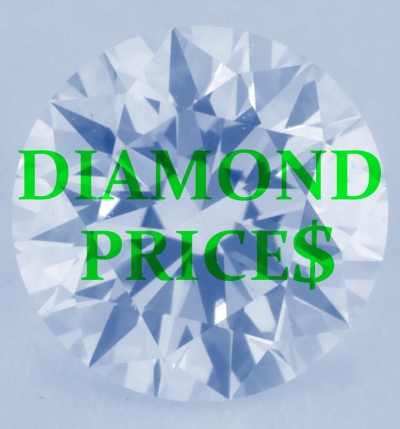Diamond Ring Types by Design and Number of Stones
The most often seen diamond ring types are solitaire rings, rings with side stones, and pave diamond rings.
Solitaire rings are made with a single diamond in the setting, usually held by prongs, although other mountings, such as the bezel setting or tension setting, are also used.
Rings with side stones have one center diamond surrounded by smaller diamonds.
One of the most popular variations of side-stone rings is the three-stone ring, which has one center diamond and two stones on each of its sides.
Check out a selection of diamond ring settings and their prices.
Pave rings are studded with small diamonds attached to the band with tiny metal prongs that look like droplets of metal. Depending on its design, such a ring can be made only with small pave-set diamonds or it could feature a bigger single stone, or a center diamond with side stones.

Pave-setting diamond ring
Diamond Rings by Type of Setting
There are different types of settings used to hold a diamond in a ring, and here are the most popular ones:
Prong settings hold the diamond with metal projections, usually four or six of them, although settings with more prongs are also made.

Typical prong setting
Bezel settings surround the stone with a band of metal, fully or partially. Settings where only part of the stone’s outer edge is held by a metal band are referred to as partial bezel settings.

Round diamond in a bezel setting
Invisible settings hold diamonds in a metal framework that is underneath the stone and is not visible from the top of the ring.
Channel settings, as the name suggests, hold diamonds in a channel made in the ring’s band.

Typical channel setting containing small diamonds
Tension settings hold the diamond between the two ends of the band by applying pressure, not by using prongs, bezels, or another type of mounting device.

This is how a tension setting holds a diamond by applying pressure to it.
Diamond Rings by Diamond Shape and Cut
Diamond shape refers to the profile of the stone, while the term “diamond cut” is more specific and is used to refer to the number, shape, and alignment of the stone’s facets.
Round diamonds are by far the most popular. The classic round cut was designed to maximize the stone’s brilliance, which surpasses that of stones with other cuts.
Oval cuts are also popular, although not as much as round ones. There are other popular cuts that are derived from the oval cut: the marquise cut (whose two ends are sharp instead of rounded), the pear cut (basically an oval cut with one sharp end), and the heart cut (an oval cut with one sharp end and a cleft on the opposite rounded end).

Marquise-cut diamond

Pear-cut diamond
Rectangular cuts include the popular princess cut, the emerald cut (a rectangular cut with truncated corners) and the Asscher cut (a square emerald cut), the cushion cut (with rounded instead of sharp or cut corners), and the radiant cut.
The classic triangular cut is referred to as trillion cut, or trilliant cut. The sides of this cut’s triangular profile can be straight or slightly rounded.
Types of Diamond Rings by Metal
The most often used metals used to make diamond rings are platinum, white gold, and yellow gold.
Platinum rings are among the most popular to set diamonds in because of the color and durability of the metal.
White gold diamond rings are also very popular, as they are relatively affordable while still being pretty durable.
Yellow gold rings wear out more quickly than white gold or platinum ones, as yellow gold is relatively softer. This material is an especially good choice for diamonds of lower color grades because the yellow tints in such stones are made less visible by the yellow color of the ring.
Types of Diamond Rings by Style
Thick vs. Thin Diamond Bands
If you are selecting a ring, it is important to consider how thick its band is, for a couple of reasons:
First, along with the type of metal used, band thickness is one of the factors affecting how hard it would be to resize the ring. Thicker bands can be hard to work with, especially if they are made of a very hard metal.
Second, how thin a band is determines how quickly it will wear out or how easily it will bend. This is especially true if the band is made of a softer metal such as yellow gold.
Wide vs. Narrow Diamond Rings
Rings with bands that are too wide can make it hard for you to move your finger. Bands that are too narrow, on the other hand, can bend or break easily.
Bigger vs. Smaller Diamonds in Rings
It is important to consider the size of the diamonds in relation to the size of the ring they are attached to.
Bigger diamonds attract more attention, but you should make sure that the ring is big enough for them. Otherwise, the piece may not be well balanced and move easily when you wear it.
Smaller diamonds are cheaper per carat, but you should ensure that they are not too small for their setting. Otherwise, they may be loose and might fall off.
How to Pick a Setting for Your Diamond Ring
The kind of setting you pick for your diamond can greatly affect how big the stone will look.

Diamond in a prong setting
In general, settings that cover a significant part of a diamond will make it appear smaller, whereas those that allow more of the stone to be seen will make it seem larger.
Also, the more of your diamond a setting covers, the less light it lets enter your stone, and as a result, the diamond will have less brilliance and its flaws may become more visible.
For example, bezel settings hold stones in place by encircling them with metal strips, concealing a good portion of the diamond.
Channel settings also have a similar effect and tend to make stones set in them look smaller.
Prong settings show more of the diamond, but this really depends on the number and shape of the prongs.
Setting with six or more prongs, or those with V-prongs, tend to make diamonds less visible. Four-prong settings, on the other hand, make your diamond as visible as possible and are the best choice if you want to underscore its size.
When choosing a setting, keep in mind that there is a tradeoff between a stone’s visibility and its safety. Settings covering your diamond with more metal tend to be more secure, but they also make stones look smaller. Settings that show more of your diamond also expose it to more direct hits that may cause it to crack.
Size of Setting
Similar to the type of setting you choose, the size of the setting also has a bearing on how prominent your diamond will be. To achieve a balanced look for your ring, you should pick a setting with the carat weight of your diamond in mind.
Make sure the setting is not too large, thick or wide for the diamond. Otherwise, the setting will overpower the stone, making it look disproportionately small.
On the other hand, if your setting is too small for the size of your diamond, the ring will look out of proportion, and the result will not be pleasing to the eye.
A related problem with a diamond that is too big for its setting is that the top of the ring will become too heavy, causing the entire piece to be out of balance and to shift on your finger.
In sum, there should be harmony between the size of the setting and that of the diamond: The setting should be just big enough to make the stone stand out while underscoring its beauty.
Diamond Color
The color of your diamond is another dimension on which you should match your stone to its setting. Sometimes, it is good to have contrast, but it should be of the right kind: The setting should make the white color in the diamond stand out, not bring out any yellowish tints the stone may have.
So, how should you apply this rule?
If your diamond is colorless or nearly colorless, have it set in a white setting, e.g. one made of platinum or white gold.
Yellow gold would make the stone look tinted, but if you are set on this metal, you can minimize the additional coloring by getting a setting that holds your stone with white prongs (made of white gold or platinum), not yellow ones.
If your diamond has some yellow tints that are somewhat noticeable, don’t have it set in white or you will make the yellow color in the stone stand out even more. This is when a yellow gold setting would be a good choice: It will bring out the white color of your stone instead of its yellow tints, which will blend with the setting’s color and become unnoticeable.
Diamond Shape
To underscore the shape of your diamond and make your ring look appealing, choose a setting shape that complements that of the stone set in it.
For example, if your diamond is round, set it in a setting that also has round and curved shapes.
If, on the other hand, you have a square stone, pick a setting that has a more angular design. In general, avoid setting-stone combinations where these two elements’ shapes do not look compatible.
Of course, deciding on this aspect of your setting is entirely up to your personal taste, and you can get creative with the design of the setting. Just make sure that when the setting and the diamond are combined, they look aesthetically pleasing to you.
Where to Buy a Diamond Ring?
We recommend James Allen (read review) because you can take a 360-degree look at any stone before having it set in a ring.
Blue Nile is another reputable diamond retailer we recommend.


















